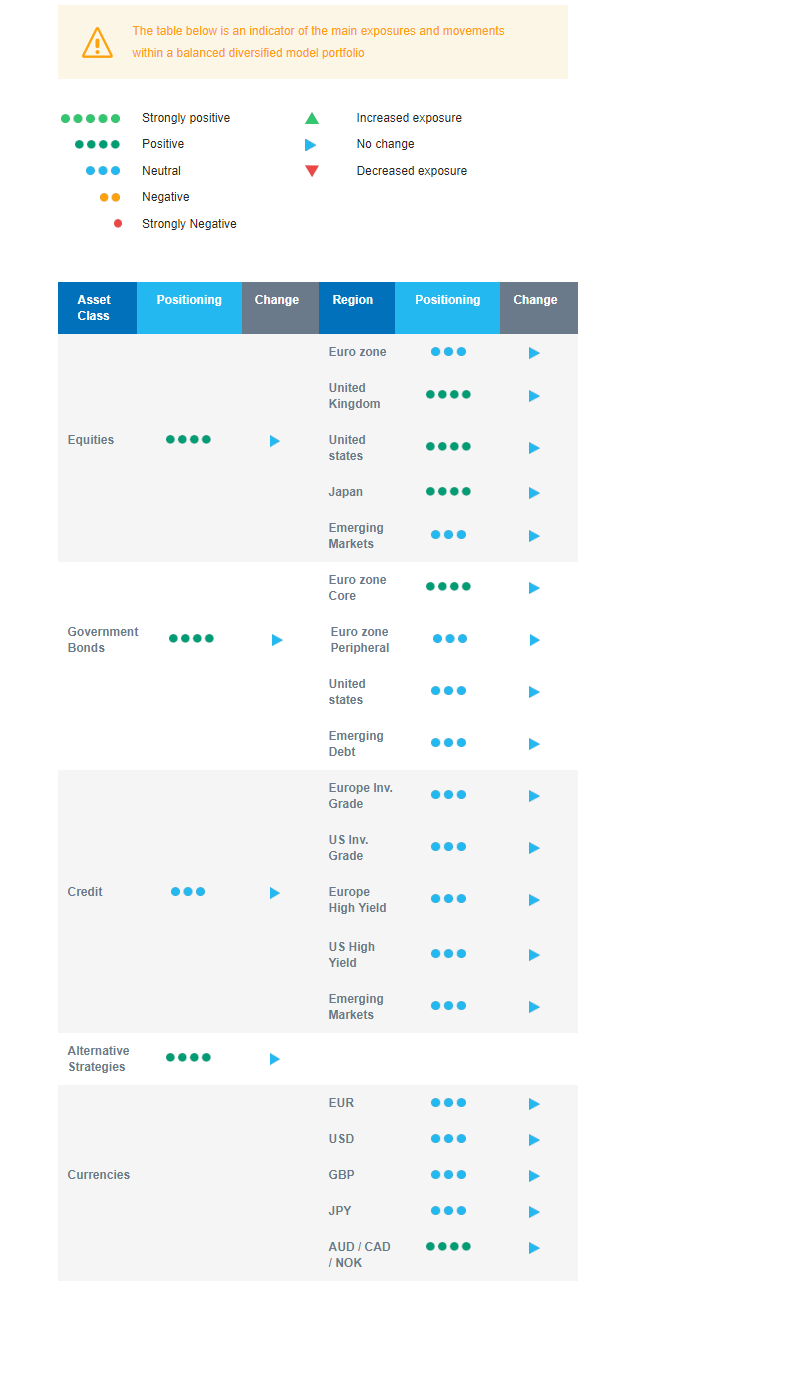Last week in a nutshell
- Flash global PMI hinted at a pick-up in the services sector offsetting an easing in the manufacturing industry.
- In the US, preliminary Q2 GDP grew 2.8% annually, up from 1.4% in Q1 and above the 2% forecast, driven by consumer spending.
- In the euro zone, preliminary consumer confidence slightly improved due to easing political concerns in France and expectations of a less restrictive monetary policy.
- The People's Bank of China cut its 1Y and 5Y loan prime rates by 10bps, in an effort to boost the economy as growth slowed to 4.7% during Q2.
What’s next?
- The earnings season continues with publication from L’Oréal, Microsoft, Meta, Apple, Procter & Gamble, Marriott.
- Central bank meetings and communications from the US, UK, Japan, and Brazil will dominate the news and help investors evaluate the pace and scale of monetary policy easing.
- In the euro zone, the focus will be on preliminary GDP growth data for Spain, Germany and the broader region. Also preliminary publications on inflation, CPI and final ones on PPI are expected.
- The US job report, including the total number of jobs added or lost in the economy, the unemployment rate, and average hourly earnings, is expected to confirm the cooling praised by Fed Chairman Jerome Powell.
Investment convictions
Core scenario
- At this stage, our scenario that interest rates have peaked and that the Federal Reserve will begin its monetary easing cycle in September is gaining traction.
- Despite slowing growth, earnings and profits remain resilient. In the US, growth forecasts are increasingly influenced by political factors. EU growth is dependent on a pick-up in consumer activity, while China's growth remains subdued.
- The cooling of inflation – and core inflation – is a synchronised global development. Supportive (i.e. lower) inflation news also paves the way for European central banks (e.g., ECB, BoE, SNB, Riksbank) to cut interest rates in Q3. With several emerging market central banks already cutting since 2023, the long-awaited global easing cycle is about to begin.
Risks
- Looking ahead, we caution against policy decisions that lead to higher tariffs and a tighter labour market in the US, which could ultimately lead to rising inflation again.
- A potential change in the White House and the reprioritisation of US economic policy could affect the speed and extent of monetary easing in case of a second Donald Trump presidency.
- The recent snap elections have put France in an unprecedented situation: a coalition must be formed to provide political stability in a context of limited fiscal space to boost supply. Next year, we see a risk of downgrade or a negative outlook in all scenarios as the debt ratio rises.
- In China, economic activity remains fragile and price developments remain deflationary as consumer confidence remains low. Additional tariffs could jeopardise continued recovery.
- Geopolitical risks to the outlook for global growth remain tilted to the downside as developments in the Middle East and the war in Ukraine unfold.
Cross asset strategy
- While we are cautious about recent political developments on both sides of the Atlantic, the upcoming policy actions support a constructive view on developed equity markets.
- We are slightly overweight US, UK and Japan but neutral on euro zone equities:
- In the US, the Q2 earnings season is supportive but data from the technology sector reports are not comparable to former quarters. We therefore locked in handsome profits and neutralised the allocation on the sector.
- In the UK, valuations remain attractive with the potential for multiple expansion and the BoE poised to cut interest rates.
- In Japan, exiting the multi-decade long deflation as well as corporate governance reforms bearing fruit should more than counterbalance a less dovish Bank of Japan.
- In the euro zone, while tail risks in France have diminished, the surprise victory of the left-wing alliance and a hung parliament imply political uncertainty. A higher risk premium remains justified.
- In the equity sector allocation:
- We focus on US and pan-European small caps. In the US, the segment should benefit from the broadening of earnings, fuelling the current rotation. In Europe, a revival in consumer spending and looser monetary policies should be an advantage.
- In the US, we have an increasingly constructive view on Healthcare. Q2 earnings indicate that the normalisation of overearning from COVID, due to destocking excess inventories and demand for COVID-specific products, is mostly complete.
- In the fixed income allocation, with monetary policy easing and political uncertainty on the rise, safe bonds are an attractive investment, while we see little room for credit spreads to tighten further:
- We favour carry over spreads, with a focus on quality issuers: we maintain our long duration bias via Germany and the UK.
- We are now neutral on US duration.
- We have a relatively small exposure to emerging markets sovereign bonds amid very narrow spreads.
- We are neutral on investment grade and high yield bonds, regardless of the issuers’ region.
- In our forex strategy and despite current volatility, we are positive on commodity related currencies.
- We expect Alternative investments to perform well as they present some decorrelation from traditional assets and keep an allocation to gold.
Our Positioning
With a constructive view on developed equity markets while taking into account the political risk, our positioning is slightly overweight equities across the US, Japan and Europe ex-EMU, while being cautious and remaining neutral on EMU. We are also neutral on emerging market equities until consumer confidence picks up.
With the US Tech sector earnings beats disappointing investors and becoming more vulnerable to tensions between China and the US, we acknowledge the current rotation in the US. We decrease our exposure to Technology and become more constructive on US Healthcare. We also add US small & mid-caps to our existing allocation in this segment. On the fixed income side, we are positive on Core European duration as a safe haven and UK duration. The objective is to benefit from the carry in a context of cooling inflation and pending rate cuts by the ECB and BoE. In credit, we remain neutral - high yield and emerging debt - amid very narrow spreads and a strong USD.

